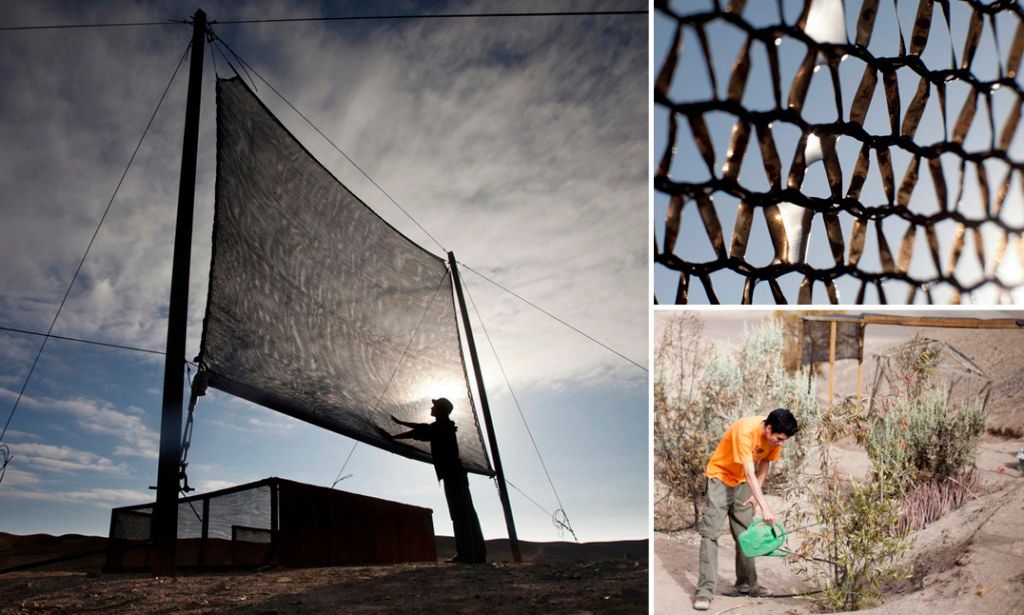
北非摩洛哥西南部的阿伊特巴哈姆哈(Ait Baamrane)村位於撒哈拉沙漠邊陲,當地一片荒漠,雨量稀少一年有六個月被濃霧籠罩。
非政府組織達爾西哈馬德(Dar Si Hmad)2015年就開始在西地伊芙妮(Sidi Ifni)的山區安裝霧水收集系統,為數百戶家庭提供食水,目前已成為全球最大的霧水收集系統,每日可以收集35,000公升水,足夠供附近1千名居民飲用和灌溉。
過往,由於水源不足,村內男性被迫到城市尋找工作,留在村內的大部分是婦女和孩童,很多婦女每天要花費三個多小時到遙遠且接近枯竭的水井中取水,家人才有水可用。

今天乾旱日益加劇,世界上四分之一人口無法獲得食水,愈來愈多國家開發收集霧氣和露水的技術,以緩解水資源短缺問題。在非洲的加納、厄立特里亞、埃塞俄比亞和南非等國早已應用類似技術來獲得食水和農業用水。
事實上,這種稱為「捕霧取水」(fog-catching或fog-harvesting)的方法是古老智慧,有考古學家發現中東和拉丁美洲數個世紀前就有類似技術。
1960年代,智利物理學家卡洛斯‧埃斯皮諾薩(Carlos Espinosa)開始開發這項技術。1956年,該國嚴重乾旱,當時已由智利大學退休的埃斯皮諾薩率先在瀕臨太平洋的安托法加斯塔(Antofagasta)市的高山上,試驗安裝「捕霧網」,收集露水。他因此項發明在1963年獲得專利,不過他將專利捐給聯合國教科文組織,供民眾免費使用。


「捕霧網」的基本工具非常簡單,由塑料(聚丙烯)或鋼絲製成的活動網固定在兩支2至4公尺高的鋼桿上,形成一張水網。將它裝設在當風的位置,當雲霧穿過時,懸浮在空氣中水珠會黏附在網格上,積聚成水,再經由導管引到容器。
這些水網成本低廉,不需要消耗能源,可以運輸或儲存,也沒有故障風險。一張40平方公尺的水網成本約1,500美元,每日大約可收集200公斤淨水,實際收集的水量視乎地理環境。
近年也有人將類似技術擴展至降雨量極少的城市,為當地提供可持續的水源。智利馬約大學(Universidad Mayor)學者維吉尼亞‧甘貝里尼(Virginia Carter Gamberini)在《Frontiers of Environmental Science》發表的研究指出,採霧技術可引用到乾旱的城市,例如智利阿塔卡馬沙漠上的上霍斯皮西奥(Alto Hospicio)。

阿塔卡馬沙漠地區每年的降雨量不到5毫米,但由於靠近太平洋,因此經常出現霧水。研究人員發現,在上霍斯皮西奥周圍100平方公里的範圍内,每日每平方公尺可收到霧水0.2到5公升,在海拔較高的地方,高峰期每平方公尺可收集10公升。
研究人員估計,若使用17,000平方公尺,即約兩個半足球場面積的水網,收集到的食水便足夠整個上霍斯皮西奧市的用量。
近年來,歐洲的葡萄牙和西班牙也有類似做法,提出了大膽的大規模收集霧氣來灌溉樹林的計劃。
西班牙大加那利島(Gran Canaria)和葡萄牙維塞烏(Viseu)地區在2019年和2020年先後發生野火,焚毀大量林木。該兩地的植樹造林日後將完全使用當地收集的霧水灌溉。同時也有人構思,美國加州也實行採霧計劃。


